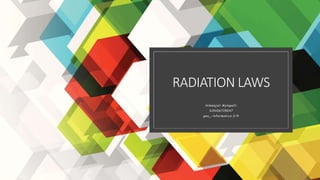
radiation laws
- 3. What is Stefan Boltzmann Law? ◦ According to Stefan Boltzmann law, the amount of radiation emitted per unit time from an area A of a black body at absolute temperature T is directly proportional to the fourth power of the temperature. u/A = σT4 . . . . . . (1) ◦ where σ is Stefan’s constant = 5.67 × 10-8 W/m2 k4 ◦ A body that is not a black body absorbs and hence emit less radiation, given by equation (1) For such a body, u = e σ AT4 . . . . . . . (2) ◦ where e = emissivity (which is equal to absorptive power) which lies between 0 to 1. ◦ With the surroundings of temperature T0, net energy radiated by an area A per unit time. Δu = u – uo = eσA [T4 – T0 4] . . . . . . (3)
- 4. Derivation of Stefan Boltzmann Law ◦ The total power radiated per unit area over all wavelengths of a black body can be obtained by integrating Plank’s radiation formula. Thus, the radiated power per unit area as a function of wavelength is: ◦ Where, ⅆ𝑃 ⅆ𝜆 × 1 𝐴 = 2𝜋ℎ𝐶2 ⅇ ℎ𝐶 𝜆𝑘𝑇 −1 𝜆5 • P is Power radiated. • A is the surface area of a blackbody. • λ is the wavelength of emitted radiation. • h is Planck’s constant • c is the velocity of light • k is Boltzmann’s constant • T is temperature.
- 5. Graphical representation Stefan–Boltzmann law: power radiated by a greybody with different emissivities.
- 7. Calculating Radius of Stars ◦ To calculate the radius of a star, its luminosity is taken into consideration. The luminosity is the total power discharged by the star in space. It depends on two factors, i.e., the temperature and surface area. The relationship between the temperature of an object, the surface area of the body, and the rate of radiation discharge is given by the Stephan- Boltzmann law. Hence, it can be used to calculate the radius of a star.
- 8. Heating Iron Rod ◦ When an iron rod is heated at one end, the heat tends to spread and reach the opposite end of the rod after some time. One of the common misinterpretations is that the energy transfer only takes place from the hot end of the rod to the cold end of the rod; however, the truth is that both the cold and hot ends of the rod exhibit thermal radiations in the environment. The difference is that the hot object radiates more than the colder one. Therefore, the net flow of heat is from the hot end to the cold end. This is one of the finest examples that effectively demonstrates Stephan-Boltzmann law in real life.
- 9. Sparklers ◦ The sparklers make use of the Stephan-Boltzmann law to emit glittery chemical particles in the environment. When a firecracker or a sparkler is lit, it undergoes a significant increase in temperature. According to the Stephan-Boltzmann law, the temperature of the object is proportional to the energy radiated by it, which is why the sparkler appears less shiny in the beginning and gets lustrous afterwards.
- 10. Bonfire ◦ A bonfire is often used during winters to keep the surroundings warm. The warmth produced by the bonfire can be easily felt from afar. This effectively makes use of the Stephan- Boltzmann law because the heat energy is emitted in the surroundings in the form of radiations.
- 11. WIEN’S LAW
- 12. What is Wien’s law? ◦ Wien’s law or Wien’s displacement law, named after Wilhelm Wien was derived in the year 1893 which states that black body radiation has different peaks of temperature at wavelengths that are inversely proportional to temperatures. ◦ Mathematical representation of the law: 𝜆𝑀𝑎𝑥 = 𝑏 𝑇 ◦ where, b is the Wien’s displacement constant = 2.8977*103 m.K ◦ T is the temperature in kelvins
- 13. Wien’s constant: b (Wien’s displacement constant) ◦ Physical constant defining the relationship between the thermodynamic temperature of the black body and the wavelength is known as Wien’s constant. It is a product of temperature and wavelength of the black body which grows shorter as the wavelength reaches a maximum with temperature.
- 14. Graphical representation Blackbody spectra for three different temperatures, 3000K (red), 4000K (green) and 5000K (blue). Notice the wavelength of the peak of each curves moves as the temperature changes. This is Wien’s displacement law. The x-axis is in nanometres, on this scale the visible part of the spectrum is from about 400 to 700 nm.
- 15. Daily life applications of wien’s law ◦ Incandescent bulb light- As the filament's temperature drops, wavelengths lengthen, making the light look redder. ◦ The temperature of the sun - With a wavelength of 500 nm in the green spectrum, which is in the human eye's sensitive range, one may analyze the sun's peak emission per nanometres.